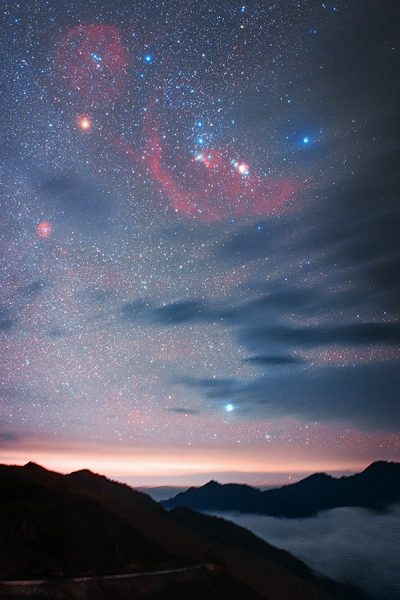The Sky This Week from February 28 to March 8 – Astronomy Magazine
The Hunter hangs above Sichuan, China
The brilliant constellation Orion the Hunter — with ruddy Betelgeuse appearing significantly brighter than it does currently — rises in an early autumn sky. Also note the glow of the Orion Nebula (M42) just to the right of the Hunter’s Belt and the huge red partial circle known as Barnard’s Loop.
Jeff Dai
One of the sky’s most familiar constellations rules March evenings from dusk until around midnight local time. Orion the Hunter appears at its highest in the south as darkness falls but grows more prominent once twilight fades away. If you’ve watched Orion over the years, you might notice that it doesn’t look quite the same now. Ruddy Betelgeuse, which marks one of the Hunter’s shoulders, is a mere shadow of its normal self. Fortunately, the red supergiant star has started to rebound from its historic low of magnitude 1.6 during February’s second week. It already has brightened by 0.1 to 0.2 magnitude, and astronomers expect it to continue this trend until it reaches its normal brightness of around magnitude 0.6
Friday, March 6
One of the sky’s largest asterisms — a recognizable pattern of stars separate from a constellation’s form — occupies center stage on March evenings. To trace the so-called Winter Hexagon, start with southern Orion’s luminary, Rigel. From there, the hexagon makes a clockwise loop. The second stop is brilliant Sirius in Canis Major. Next, pick up Procyon in the faint constellation Canis Minor, then the twins Castor and Pollux in Gemini, followed by Capella in Auriga, Aldebaran in Taurus, and finally back to Rigel.
Saturday, March 7
Venus gleams in the western sky after sunset. The brilliant planet stands out just a half-hour after sundown, when it stands nearly 40° above the horizon, and it is still 25° high once darkness fully settles in. Venus remains on display until after 9:30 p.m. local time. Shining at magnitude –4.3, it is by far the brightest point of light in the night sky. A telescope reveals the planet’s disk, which spans 20″ and appears 60 percent lit. And as a bonus, Venus serves as a guide to the solar system’s seventh planet, Uranus, tonight and tomorrow night. Because the distant world glows feebly at magnitude 5.9, you’ll need binoculars or a telescope to spot it. Once the sky grows dark tonight, center Venus in the field of view and then search for Uranus 2.2° to its southeast (to the left when viewed from mid-northern latitudes). Don’t confuse the ice giant world with a similarly bright star even closer to Venus. Uranus lies about twice as far from Venus as that star. You can remove any doubt by targeting the objects through a telescope. Only Uranus will show a 3.4″-diameter disk and conspicuous blue-green color.
Sunday, March 8
Venus and Uranus appear equally as close this evening as they did yesterday, though their relative positions have changed. Tonight, Uranus lies just a bit east of due south (to the lower left) of Venus. By the way, the actual conjunction between these two planets occurs at 11 a.m. EDT tomorrow, but the two will stand 2.6° apart by the time darkness falls.
For most people in the United States and Canada, daylight saving time begins at 2 a.m. local time this morning. Set your clocks ahead one hour.
Neptune is in conjunction with the Sun at 8 a.m. EDT. The distant planet is hopelessly lost in the solar glare but will return to view before dawn in late April.






